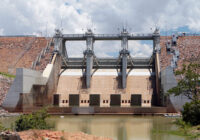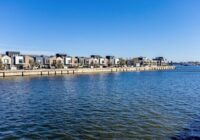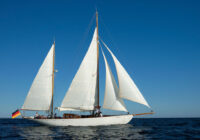Marine Rescue NSW Southern Zone Commander undertakes Churchill Fellowship research into the implications of future boating technology for marine rescue organisations
The Winston Churchill Trust awards fellowships to people across a range of disciplines, giving them the opportunity to travel and research ways to improve their community at home, with around 100 fellowships awarded each year in Australia.
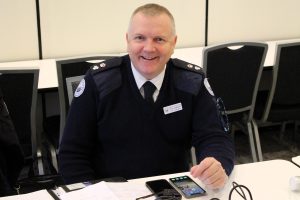
Marine Rescue NSW Southern Zone Commander Mike Hammond
Marine Rescue NSW Southern Zone Commander Mike Hammond applied last year and was awarded a 2024 Churchill Fellowship to study how marine rescue services in Australia must adapt to new boating technologies.
He is a lifelong recreational boater and has been a commercial skipper for over 20 years.
Noticing that electric boating was growing in popularity, with many more electric boats and motors entering the market—and quite large electric boats, up to eight metres in length, displayed at the Sydney Boat Show—Zone Commander Hammond started to wonder what it might mean when operators of these boats call Marine Rescue NSW for help in the future. This concern extended to both how they could be assisted and how the Service’s volunteers could be kept safe in the process.
“Electric boats tend to be fitted with lithium batteries, in some cases quite large ones. While the high-quality batteries used for marine propulsion are very safe, some lithium batteries in other types of products have failed, sometimes quite spectacularly, and we can’t rule out a battery failure in a boat at some stage,” he said.
“Just as our counterparts in the fire and land rescue services are grappling with how to deal with battery and EV incidents, I wanted to look at what it means for Marine Rescue NSW and our interstate partners.”
Zone Commander Hammond travelled for six weeks in January and February, visiting the UK, Sweden, Germany, Ireland, the USA, and Japan. Along the way, he met with marine rescue organisations, including the Royal National Lifeboat Institution, the Swedish Sea Rescue Society, the US Coast Guard, the Japan Coast Guard, and the marine rescue sections of the Chicago and Miami-Dade Fire Departments. He visited several boat builders and had the opportunity to experience a few electric boats first-hand, while also attending two of the largest boat shows in the world—Boot Düsseldorf and the Miami International Boat Show.
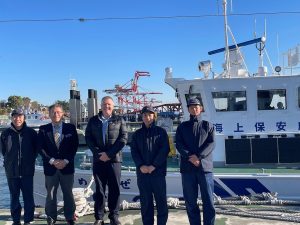
Mike travelled to Tokyo and met with officers from the Japan Coast Guard
What he found was that many boat builders are embracing electric propulsion, including some in Australia, with recreational and commercial vessels already in service worldwide, powered by battery-electric systems, hybrid systems, and even electric vessels powered by hydrogen fuel cells.
“Many of these vessels also include other advanced technologies, such as carbon fibre construction and active hydrofoil systems, and it seems likely that some unique and different types of vessels will be on our waters over the next few years.
“There are also some marine rescue organisations exploring these technologies for rescue vessels, not only for the environmental benefits but also for practical benefits—such as the smooth ride provided by hydrofoils reducing crew injuries and the silent operation of electric propulsion assisting in search situations.
“I also learned that only a few of these organisations have started to think about what these innovations might mean for volunteer safety, and few are collecting rescue data in a way that identifies if an alternative propulsion system was a factor. We need to put some strategies in place to understand and prepare for rescues involving these kinds of vessels,” he said.

Mike was all smiles after riding the amazing Candela P12 foiling electric passenger ferry in Stockholm
Zone Commander Hammond looked at other innovations during his journey, including the use of artificial intelligence watch-keeping systems.
“The technology is being increasingly used to ensure safe navigation and has the potential to be very useful in search and rescue at sea.”
He is now working on a report and several recommendations for marine rescue organisations, maritime regulators, and the marine industry to ensure that when Marine Rescue NSW receives a call for help from someone on an electric, hybrid, or hydrogen vessel, the Service will have procedures, training, and equipment in place to respond safely and effectively.
Zone Commander Hammond has been invited to present his findings to the NATSAR Council and the National Volunteer Marine Search and Rescue Committee.
“I am hoping the distribution of my report will help move the conversation along about alternative propulsion and help ensure that marine first responder safety becomes part of that discussion.
“I am grateful for the faith the Winston Churchill Trust has put in me. It has been a great opportunity to ‘learn globally, inspire locally’,” he said.
Marine Rescue NSW is a volunteer based not-for-profit professional organisation dedicated to keeping boaters safe on the water and supporting local communities.









